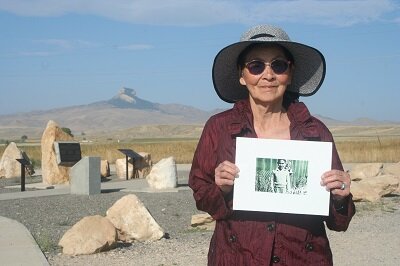 By Will KakuThe Heart Mountain concentration camp has always represented a critical turning point for my father’s family. As I had written in previous articles and speeches (links to some of these are below), Heart Mountain was the place where my father and his brothers struggled and debated as to how they were going to answer the infamous Questions 27 and 28. Heart Mountain was the location where my Uncle Tak decided that he was going to resist the draft. Heart Mountain was where my Aunt Itsu made a dramatic transformation from an innocent, acquiescent, and naive young women to one who became more aware of her dire situation and more vocal about racial discrimination and the violation of her civil rights.
By Will KakuThe Heart Mountain concentration camp has always represented a critical turning point for my father’s family. As I had written in previous articles and speeches (links to some of these are below), Heart Mountain was the place where my father and his brothers struggled and debated as to how they were going to answer the infamous Questions 27 and 28. Heart Mountain was the location where my Uncle Tak decided that he was going to resist the draft. Heart Mountain was where my Aunt Itsu made a dramatic transformation from an innocent, acquiescent, and naive young women to one who became more aware of her dire situation and more vocal about racial discrimination and the violation of her civil rights.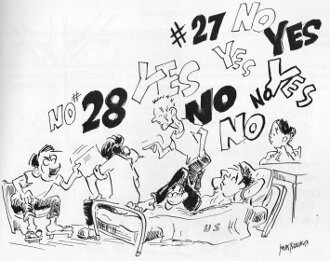 Despite that significance in my family’s history, I could never find the time to make the journey to the Heart Mountain Interpretative Center. During the fall, my mother told me she wanted to visit Yellowstone National Park, so I decided that I could finally combine that trip with a visit to the old camp site which is just an hour drive from the park.
Despite that significance in my family’s history, I could never find the time to make the journey to the Heart Mountain Interpretative Center. During the fall, my mother told me she wanted to visit Yellowstone National Park, so I decided that I could finally combine that trip with a visit to the old camp site which is just an hour drive from the park.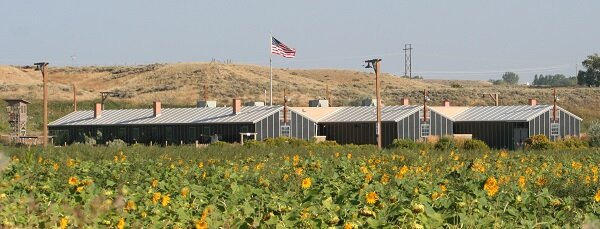 The Heart Mountain Interpretative Center opened in 2011, just a year after we completed the major renovation of JAMsj. Because I assisted in providing content for the JAMsj camp exhibit, I was fully aware of space, cost, and vision constraints that had to be considered in exhibit design. I was keenly interested in how the Heart Mountain Wyoming Foundation (HWMF) presented the Japanese American incarceration story to the public in their facility.
The Heart Mountain Interpretative Center opened in 2011, just a year after we completed the major renovation of JAMsj. Because I assisted in providing content for the JAMsj camp exhibit, I was fully aware of space, cost, and vision constraints that had to be considered in exhibit design. I was keenly interested in how the Heart Mountain Wyoming Foundation (HWMF) presented the Japanese American incarceration story to the public in their facility. One major aspect of the HWMF presentation, the first-person narrative, is extremely effective in bringing out an emotional connection to an infamous event in our nation’s history from over 75 years ago. After a short museum overview, my mom and I were encouraged to view the short film, All We Could Carry, by Oscar-winning filmmaker, Steven Okazaki. All We Could Carry powerfully captures the devastating impact of incarceration at Heart Mountain through the voices of former inmates.
One major aspect of the HWMF presentation, the first-person narrative, is extremely effective in bringing out an emotional connection to an infamous event in our nation’s history from over 75 years ago. After a short museum overview, my mom and I were encouraged to view the short film, All We Could Carry, by Oscar-winning filmmaker, Steven Okazaki. All We Could Carry powerfully captures the devastating impact of incarceration at Heart Mountain through the voices of former inmates.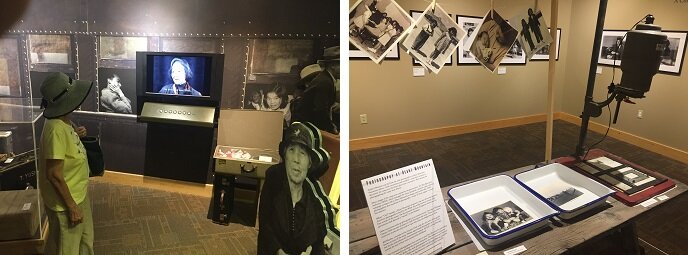
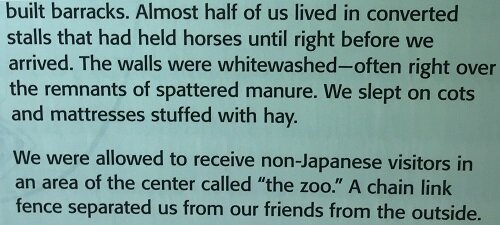 Several kiosks in the museum also incorporate moving first-person accounts. Exhibit placards continuously reinforce the first-person point of view by utilizing the inclusive pronoun "we". We felt that we were also making our own journey through the great civil liberties and human rights tragedy from WW II.
Several kiosks in the museum also incorporate moving first-person accounts. Exhibit placards continuously reinforce the first-person point of view by utilizing the inclusive pronoun "we". We felt that we were also making our own journey through the great civil liberties and human rights tragedy from WW II.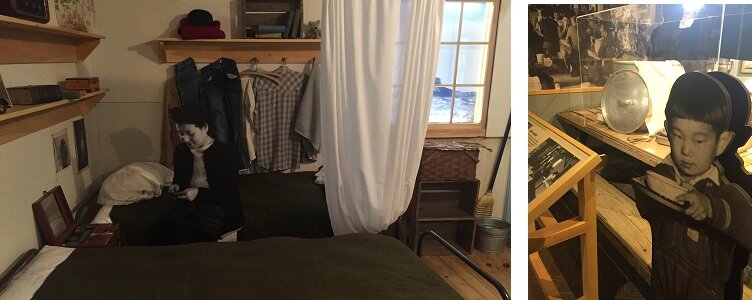 The 11,000 square feet of space also enables exhibit images and artifacts to extend out into the floor space, providing a fully immersive experience to the visitor.
The 11,000 square feet of space also enables exhibit images and artifacts to extend out into the floor space, providing a fully immersive experience to the visitor.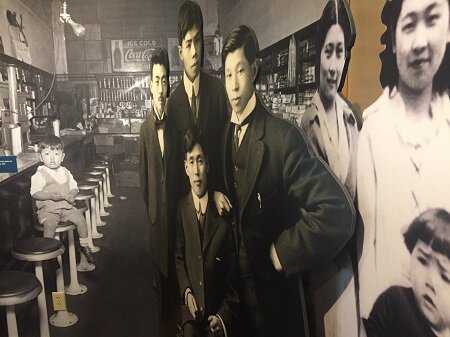 Every square foot of the museum is used to transport you back into the diverse and complex Japanese American incarceration experience. Even the reflective restroom toilet stalls convey the feeling of embarrassment and the loss of privacy that many former inmates experienced in the camps.
Every square foot of the museum is used to transport you back into the diverse and complex Japanese American incarceration experience. Even the reflective restroom toilet stalls convey the feeling of embarrassment and the loss of privacy that many former inmates experienced in the camps.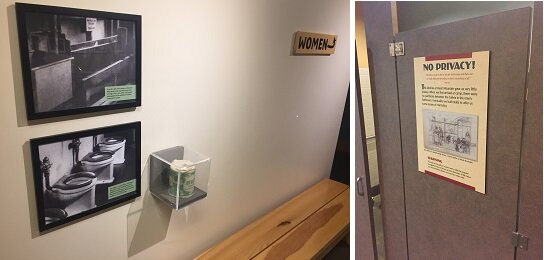 Importantly, the museum exhibits challenge visitors with questions that are pertinent to our lives and political discourse today. One display asks us about what we think about the 14th Amendment and birthright citizenship. Another asks us if there are any circumstances under which the curtailment of civil liberties by the government is justified.
Importantly, the museum exhibits challenge visitors with questions that are pertinent to our lives and political discourse today. One display asks us about what we think about the 14th Amendment and birthright citizenship. Another asks us if there are any circumstances under which the curtailment of civil liberties by the government is justified.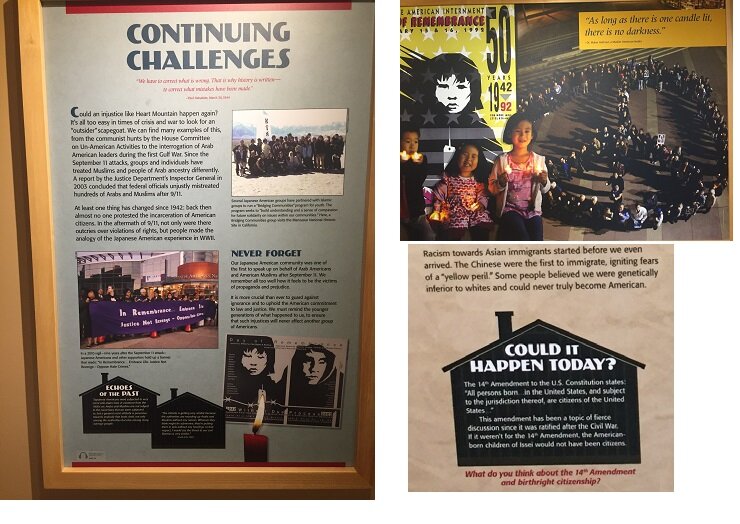 It took us a long time to explore the many museum displays and my mother became tired. We came back the next morning and wandered around the self-guided walking tour next to the museum. We saw the locations of the Heart Mountain hospital where my father worked for a short time, the school that he attended, and the train station where my father boarded a train that transferred him to the Tule Lake camp. We walked solemnly during that quiet, cool morning and we reflected on his life.
It took us a long time to explore the many museum displays and my mother became tired. We came back the next morning and wandered around the self-guided walking tour next to the museum. We saw the locations of the Heart Mountain hospital where my father worked for a short time, the school that he attended, and the train station where my father boarded a train that transferred him to the Tule Lake camp. We walked solemnly during that quiet, cool morning and we reflected on his life.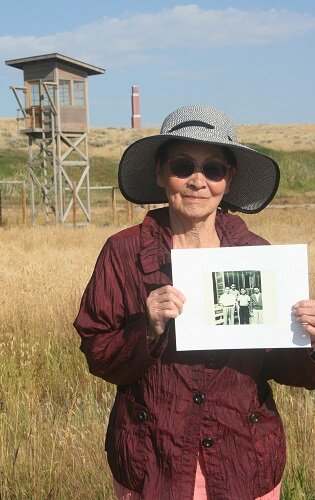
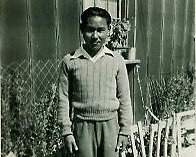
 --------------------------------------------------------------------------------------------------------------------------------------Related articles by Will Kaku:Lost WordsThe Secret of Tule LakeLiving HistoryPower of Words: Internment Camp or Concentration Camp
--------------------------------------------------------------------------------------------------------------------------------------Related articles by Will Kaku:Lost WordsThe Secret of Tule LakeLiving HistoryPower of Words: Internment Camp or Concentration Camp
The Importance of Japanese American Traditions
By Susan NakamuraOne of the goals of the Japanese American Museum of San Jose (JAMsj) is to preserve the unique history of our ancestors for future generations and to share their accomplishments and hardships with others. Japanese Americans can trace their roots to Japan. But their immigration to America, farming experience, and incarceration during World War II have combined to create Japanese American identity and culture.As a young girl, I recall my mother pointing out my grandfather as an example of gaman: persevering through difficult times with hard work and without complaining. Through his example I should learn these virtues. Because my grandfather was born in Oahu, Hawaii, at that time a U.S. territory, he was a dual citizen of the United States and Japan. The family came stateside in 1906, the year of the San Francisco earthquake. They were forced to move every four years because the California Alien Land Law of 1913 prohibited Japanese from owning land or possessing leases for more than three years.My grandmother was a picture bride from Kumamoto, a province on the island of Kyushu in Japan. Initially, my grandmother and her father were reluctant to have her travel to a ‘foreign’ country and unknown land. Her father later changed his mind. He told my grandmother that if she went to America and married my grandfather, they would return to Japan in three years. As it turned out, they never returned to Japan.My Grandmother Kajiu changed her name to Yoso, because Kajiu was also the name of my grandfather’s mother. And two Kajius in America would be too confusing. She took the name Yoso, her older sister’s name, who died earlier from a brain hemorrhage after working in the rice fields.According to papers, my grandparents were married in 1919, but my grandmother did not make her journey to America until 1920. She sailed out of the port of Nagasaki on the SS Persia Maru, the last ship for picture brides from Japan. The journey to California took 27 days, with a stop in Hawaii to let off other picture brides.Like many Japanese immigrants in Santa Clara valley, they worked as farmers. They grew strawberries and vegetables in Sunnyvale, San Jose, and Campbell while they raised their growing family. In about 1940, the family of seven children moved back to Campbell, where they lived in a tar-paper house with an outdoor furo (bath) and latrine (outhouse). The location of the property was on Union Avenue, not too far from the Pruneyard shopping center, which at that time was a prune orchard.During WWII, the family was incarcerated in the Heart Mountain Relocation Center in Wyoming. The family members traveled there by train with the blinds drawn down; they were not allowed to look out the window. Then they were transported in military trucks to the barracks. They saw their first snow ever, and to these Californians it was very cold. Their barracks had a pot belly coal stove in the middle and army cots for beds. The mess hall, bathroom, and washroom were in another building. There were blizzards in the winter and thunderstorms in the summer.After the war ended in 1945, my grandparents’ family members returned to Campbell. They were fortunate that their landlord, Mr. Whipple, had watched their house and belongings. But they had to start from scratch to get on their feet and earn a living. They picked prunes, prunes, and more prunes, because it was a family job, one in which everyone worked together. Later they became sharecroppers, growing strawberries with other white farmers.Growing up in Santa Clara Valley, our extended family traditions included mochitsuki, obon, and hinamatsuri. It is amazing that these traditions could survive through all the hardships of life in America.At JAMsj, these traditions are being carried forward so that future generations and the community can learn about their roots or the roots of their friends. Strong personal virtues and a sense of one’s roots can help develop your own identity and define who you are. And that is why we at JAMsj feel it is important to have programs and events to celebrate, commemorate, and uphold these traditions.For more information about internment camps and to view a replica of a camp barrack, visit JAMsj at 535 North Fifth Street in San Jose. Completely run and operated by community volunteers, JAMsj is open from Thursday through Sunday, 12 noon to 4 p.m. The admission fee is $5 for adults; $3 for seniors and students; and free to members, children under 12, and active military. We would love to see you.Please join JAMsj on March 1 for our annual hinamatsuri festivities. Children and their parents will be able to create items with paper, glue, and other crafting supplies. Hinamatsuri activities are fun, social, and open to the public. Adult helpers will be on hand to supervise these fun art activities.(I credit my aunt, June Takata, who was the unofficial family historian, for the many details included here. I also picked prunes.)





